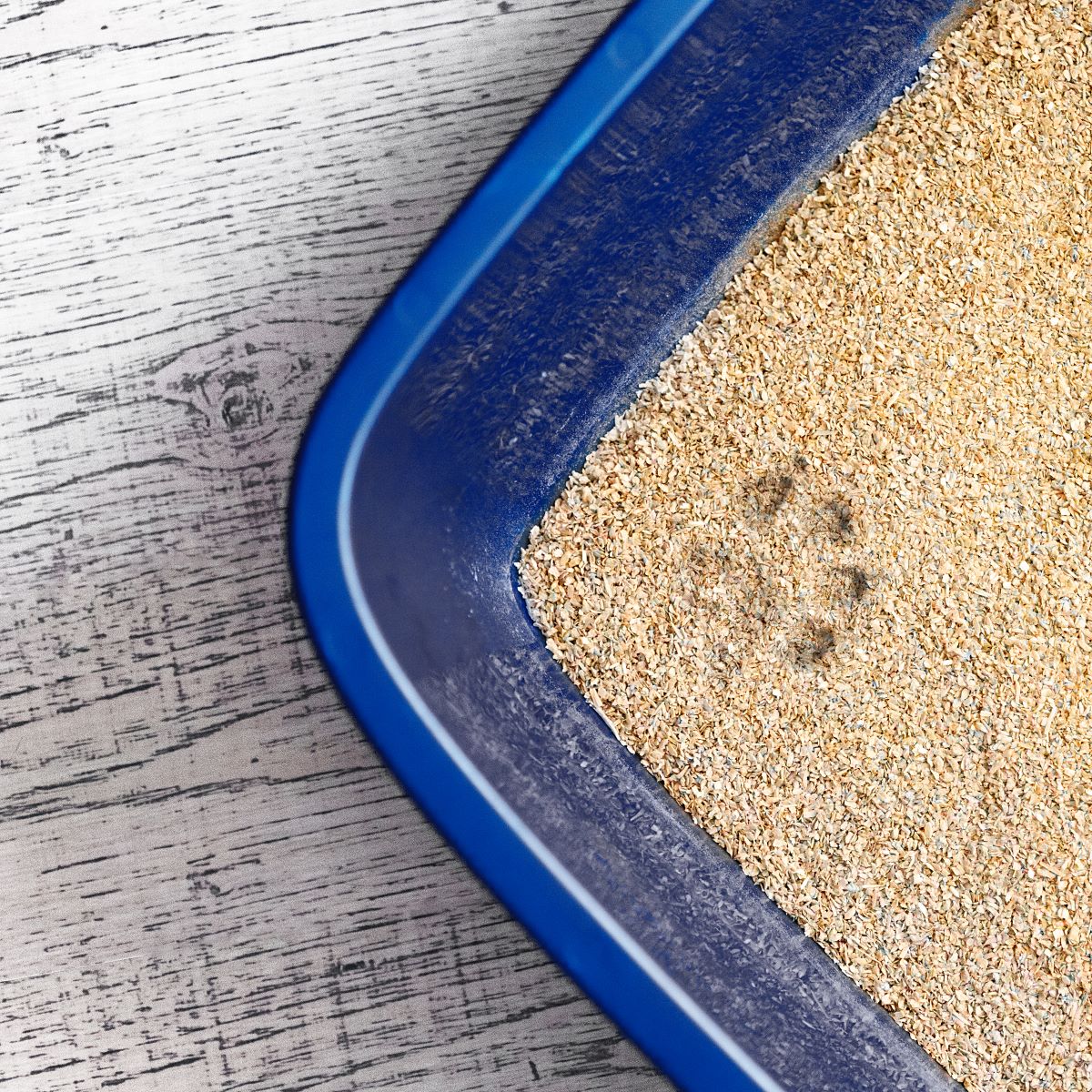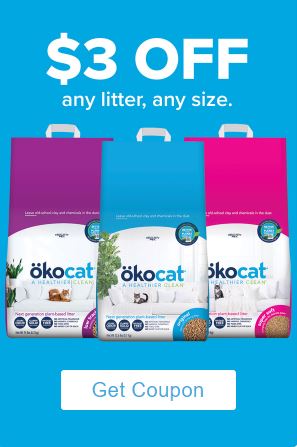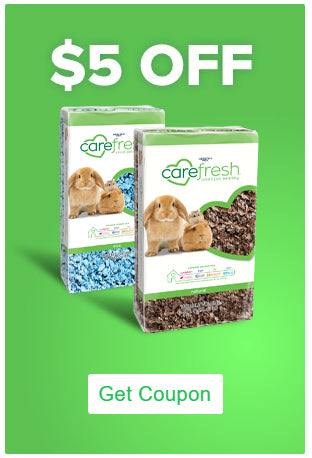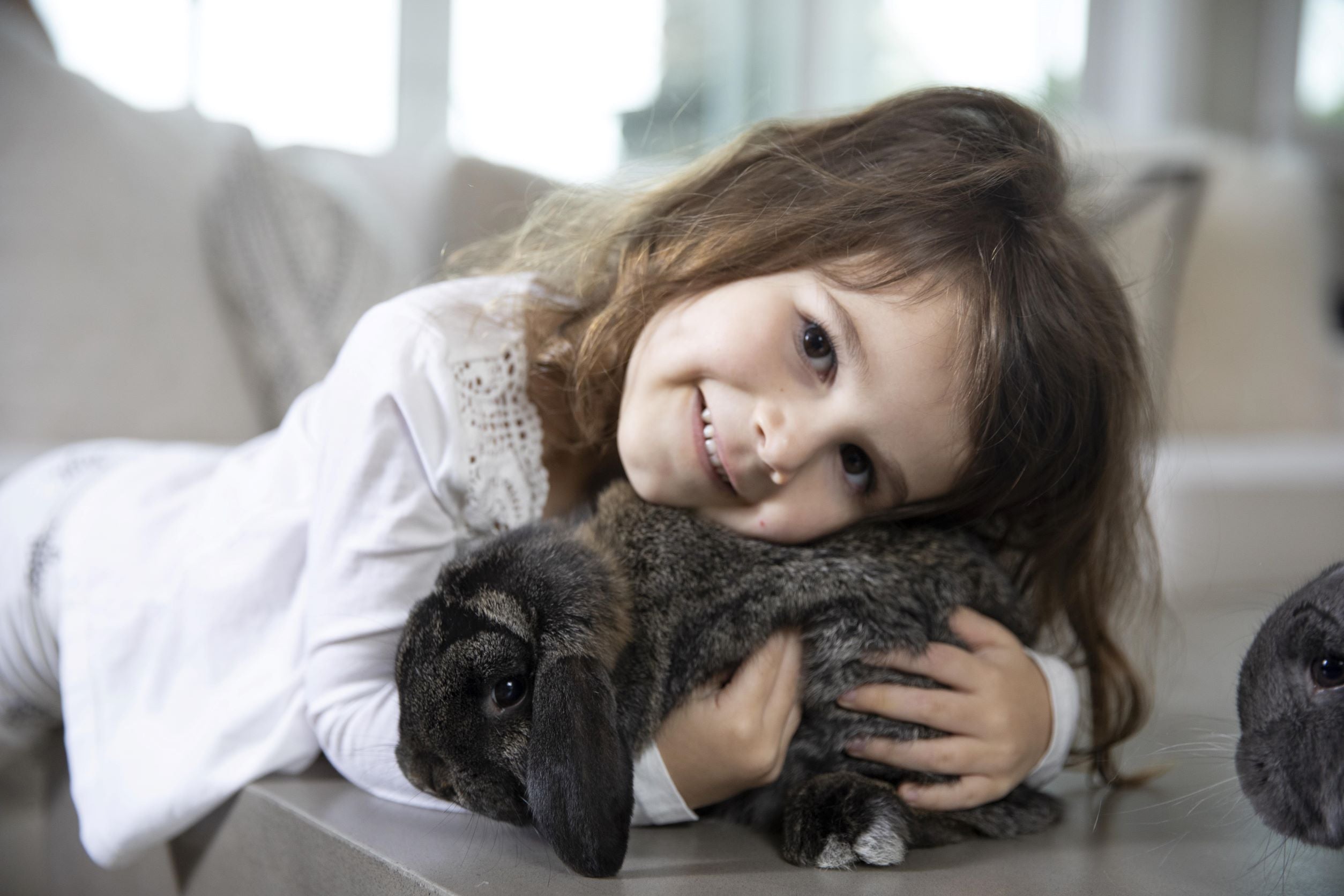Your Ultimate Guide to Choosing the Right ökocat Litter for Your Cat's Needs
Choosing the right cat litter might not seem like a big deal—until your cat decides it is. Whether you're new to the ökocat brand or simply looking to try a different formula, this guide will help you find the perfect match for both your cat’s needs and your lifestyle.
Why ökocat?
ökocat is a natural, plant-based cat litter made from sustainably sourced wood fiber—free from harmful chemicals, synthetic fragrances, and dusty clay or silica. It's designed to be healthier for your cat, your home, and the planet. But with several formulas to choose from, how do you know which one is right for you?
Let’s break it down.
1. Best for Long-Haired Cats: ökocat Low Tracking
If your feline has a fabulous coat that tends to trap litter between their toes, Low Tracking is your go-to. This formula is made of mini pellets that are easy on paws and less likely to cling to long fur and get kicked out of the litter box.
Top Benefits:
Mini-pellets that won't stick to paws or hair
Excellent clumping and odor control
Low tracking
2. Best for Odor Control: ökocat Original
If you need serious odor control, especially in a multi-cat household, ökocat Original Premium natural cat litter delivers. This formula locks in moisture and neutralizes odors on contact—without any artificial fragrances.
Top Benefits:
Superior odor control
Clumps tight for easy scooping
Long-lasting with less waste
3. Best for Cats with Sensitive Systems: ökocat Dust-Free or Low Tracking
Got a sneezing kitty (or human)? Try Dust-Free or Less Mess—both are crafted for cats (and people) who are sensitive to dust or fragrances.
Dust-Free:
Clean paper fiber with virtually no dust
Ideal for allergy-prone cats and homes
Also great for post-surgical needs
Low Tracking Less Mess:
Pellet-style litter that stays in the box
Great for active diggers or messy cats
4. Best for Kittens: ökocat Super Soft or Dust-Free
Kittens deserve a gentle start, and Super Soft natural wood clumping cat litter is perfect for tiny paws and early litter box training. For kittens with extra sensitive noses or respiratory systems, Dust-Free is also a safe pick.
Why It Works:
Non-toxic and natural
Gentle on small paws
Safe if accidentally ingested during learning but always monitor carefully if they eat too much
5. Best for Eco-Conscious Cat Parents: All ökocat Litters
Honestly, all ökocat formulas are eco-friendly, biodegradable, and sustainably sourced. They're made from reclaimed wood and are 100% compostable—yes, even the packaging! You can feel good about what you’re buying and where it ends up.
Quick Comparison Chart
okocat Formula
Best For
Texture
Clumping
Dust Level
Super Soft
Sensitive paws, kittens
Fine, soft
✔️
Low
Original Clumping
Odor control, all cats
Medium granules
✔️
Low
Low Tracking
Long hair cats, active diggers, tracking control
Pellets
✔️
Low
Dust-Free
Allergies/sensitivity
Fine, refined fiber
No
Virtually none
Final Tips for Success
Transition gradually. Mix ökocat with your old litter over 7–10 days to help your cat adjust.
Scoop daily. While ökocat lasts longer, frequent scooping keeps the box fresher.
Choose the right litter box. Low-walled boxes work best for kittens, while high-sided ones help reduce mess with pellet formulas.
Ready to Make the Switch?
No matter your cat’s personality, coat type, or sensitivities, there's an ökocat litter that fits purr-fectly. Natural, effective, and safe—it’s litter made for living.
👉 Explore all ökocat formulas here and find your feline’s favorite today!
Read MoreEco-Friendly Cat Care: Try Out These Sustainable Products for Your Cat
Of course, pet care is possible even with sustainable options. Nowadays, many pet owners are updating their pet care practices to maintain eco-conscious values. Hence, it is possible to fully care for your cat while reducing your environmental footprint at the same time.
In fact, some of the most common sustainable products for cats include biodegradable litter and organic toys. Also, with the help of other eco-friendly products, you will be able to make your cat care responsible and rewarding.
Therefore, read on to get a better idea of how to take care of your cat in a sustainable manner. This way, you will be able to be responsible towards both the environment and your cat.
Why Bother About Eco-Friendly Cat Care? - Top Reasons
Although your cat might be your small and furry friend, it does have a significant environmental impact. In general, the products you buy for your cat contain a lot of chemicals, plastics, and non-renewable materials. As a result, they contribute to a lot of waste and pollution.
The following are some examples of products that contribute to waste and pollution:
Clay-based cat litter is mined from the earth. This leads to habitat destruction and water contamination.
Synthetic toys and accessories mostly end up in landfills. As a result, they take hundreds of years to decompose.
Meanwhile, if you switch to sustainable alternatives, you will be able to protect the environment. Also, you will be able to make your home healthier for your cat. This is because many eco-friendly products are natural and non-toxic. Hence, they are safe for both humans and pets.
In addition to that, if you support green brands, you will encourage innovation. Thereby, you will be able to build a more sustainable future for all.
What Sustainable Products to Buy for Your Cat?
The following are some of the most popular sustainable products you must invest in for your cat:
1. Look for Sustainable Cat Litter Options
Initially, by switching to eco-friendly cat litter, you will be able to go green easily. The following are some of the most popular options:
Corn-based Litter: In general, these are made from renewable corn. Also, they are biodegradable and effectively control odor.
Wheat-based Litter: This is another natural option for cat owners. Apart from that, wheat litter clumps well. Also, they are gentle on cat paws.
Recycled Paper Litters: Essentially, these are soft and absorbent. Hence, they are ideal for cats with sensitive paws or respiratory issues.
Wood/Pine Pellets: Primarily, pellets are made from reclaimed wood. Thereby, they provide a fresh and natural scent. Hence, you will not get the odor of cat litter.
However, when choosing litter, always select products that are free from artificial/chemical fragrances. Moreover, it is even better if the packaging is recyclable. okocat natural litter with 100% recyclable bag is the perfect option!
2. Go for Eco-Friendly Cat Food and Treats
Basically, sustainable cat food is not about mere organic ingredients. Rather, they are also about ethical manufacturing and minimal packaging.
Hence, make sure the brand from which you buy cat food is manufactured in the following ways:
They manufacture meat from plant protein.
There are no artificial preservatives or fillers in the cat food.
They must package their products in recyclable or compostable materials.
They always support local farms. Also, they have transparent supply chains.
In addition to that, you will find even refillable containers with some companies. Moreover, if you want to reduce waste, go for bulk buying. Apart from that, you will find sustainable organic catnip, freeze-dried fish snacks, and even homemade biscuit recipes that are both tasty and eco-conscious.
3. Always Buy Green Grooming Products
Although cats like to always clean themselves, they might require occasional grooming from time to time. This is important if your cat is a long-haired breed. However, most traditional shampoos and wipes contain harmful chemicals. As a result, they irritate your cat’s skin.
Hence, always choose natural grooming wipes made from bamboo or cotton. Apart from that, look for organic shampoos. These might include ingredients like aloe vera and oatmeal. In addition to that, always buy reusable grooming tools like stainless steel combs. Also, you might go for brushes with wooden handles.
In general, these products are mostly gentler on your cat. Also, they are obviously better for the planet. Apart from that, they are always packaged in recyclable materials. Thereby, you will be able to reduce your household waste.
4. Choose Sustainable Toys and Accessories
It goes without saying that cats love to play. That is why toys are essential for their mental and physical health. However, most toys are made from plastic, synthetic fabrics, or rubber. Hence, they are harmful to both your cat and the environment.
The following are some of the things you must look for when you buy toys for your cat:
Always choose toys that are made from recycled materials like felt or denim.
You might also buy organic cotton mice. In some cases, they are stuffed with natural catnip.
When you purchase cardboard scratchers, opt for those made from post-consumer waste.
Make sure to choose wooden climbing trees sourced from sustainable forests.
Eco-Friendly Cat Products Are the Best for Your Cat
When choosing sustainable products, ensure they meet the necessary safety standards. In most cases, biodegradable litter has effective odor control and clumping ability. Similarly, recycled toys are also durable enough to withstand your cat’s claws and teeth.
Hence, when you are buying eco-friendly products for your cat, you do not have to worry about your cat’s protection.
Read MoreKeeping a Cat and Labrador Puppy Together at Home: Things to Handle
Photo by Krista Mangulsone on Unsplash
Adopting a new Labrador puppy at home is always exciting but becomes a critical decision if you already have a cat at home. Most people think that keeping a cat and a dog together at home is a difficult task, and sometimes it becomes impossible to handle them.
However, with careful planning and consideration, you can keep them together. In fact, your cat will be very happy when it gets a companion. While both the cat and pet have distinct personalities and needs, one thing is common among them: both want companionship.
So, there is a chance to keep them together only if you go into detail to understand them. It is not about the home but the people who stay there. So, if your pets want to stay together, only then will it be possible. If you are in fear of mismatch, there will be, but don’t worry, there are ways to handle this.
Things to Consider
Have you not seen two different kinds of people staying together for a lifetime? Well, I have seen this among various couples and friends. From personal experience, I can say that I have friends who do not at all exhibit the same characteristics.
So, there will be personality mismatch, difference in preferences, but White Labrador puppies are quite friendly when it comes to staying at home. While your cat possesses a different personality, it completely depends upon how you introduce them to each other.
This will surely set up the backbone of a harmonious household. Let's find out some essential tips to help you succeed.
1. Gradual Introductions Are Key
You cannot expect your puppy to mix with the cat overnight. Also, cats have strong personalities, and thus it is obvious that they will not match with your dog.
However, you can start with small steps. For instance, try to allow them sniff each other’s belongings like toys and blankets. This way you will be familiarizing yourself with each other’s scents.
After a couple of days, you can allow them to see each other. Well, it might not be a direct show, but allow them while keeping distance. Maybe from small gateways they can see each other. This way they will try to understand each other without feeling threatened.
2. Create Safe Spaces
Cats often feel overwhelmed. In such times, they want to escape from the place. To handle this situation and to make your cat feel safe, allow it access to high spaces.
This way your cat can observe the labrador from shelves and cat trees without feeling overwhelmed. The process allows better bonding without setbacks and fights.
3. Supervise Interactions
Always supervise interactions between your Labrador puppy and your cat, especially in the beginning. Puppies, especially energetic breeds like Labradors, may not yet understand boundaries.
Keep a close eye out for any signs of aggression or undue stress from either pet. If your puppy is overly excited or your cat seems fearful, intervene and separate them for a while.
4. Positive Reinforcement
Use treats and praise to encourage positive behavior between your cat and puppy. Whenever they are calm near each other, reward them.
This will help create positive associations and reinforce good behavior. For instance, if your Labrador lies calmly while the cat is nearby, give them both treats to celebrate their calm presence.
5. Training the Puppy
Training is crucial for ensuring a peaceful coexistence. Teach your Labrador basic commands like “sit,” “stay,” and “leave it.” This will help manage their impulsive behavior. Consistent and positive reinforcement training can help your puppy learn to respect the cat’s space and boundaries.
6. Scheduled Feeding and Playtime
Maintaining a routine can minimize stress for both pets. Feed them in separate areas to prevent any food-related aggression. Create playtimes for the puppy that do not interfere with the cat’s peace.
Ensuring that both pets have their own time for interaction and quiet will help them adjust to living together.
7. Be Patient
Every pet is unique, and the time it takes for them to become comfortable with one another can vary. Some cats might take weeks or even months to accept a puppy. Be patient and allow them to adapt at their own pace. Keep in mind the ultimate goal is a peaceful and harmonious relationship.
Maintain a Long-Term Harmony
There is nothing more delightful than keeping your Labrador puppy and cat together at home. With the following steps, you can surely create a bond among them while they find belongings at your home with the dedicated culture of staying together.
However, throughout this process, try to respect their unique characteristics and introduce them to things and steps mindfully. This way you can get a family that you have always dreamt of.
The key is to be -
Attentive
Patient
Understanding their needs
Make them well-behaved happy pets.
Read MoreThe Environmental Benefits of Natural Cat Litter: Why It’s Time to Ditch the Clay
As cat parents, we do a lot to care for our feline friends — feeding them the best food, giving them comfy places to nap, and keeping their litter boxes clean. But have you ever stopped to think about the impact your litter choice has on the planet?
Traditional clay litter might be a go-to for convenience, but it comes at a steep environmental cost. The good news? Natural cat litter like okocat is not only better for the Earth, it’s also better for your cat. Here’s why making the switch is a simple way to do good — for both your pet and the planet.
1. No Strip Mining, No Problem
Clay litter is made from bentonite, a material that’s extracted through strip mining — a destructive process that removes entire layers of the earth’s surface, destroying ecosystems and contributing to erosion and water pollution.
Natural litters, on the other hand, are made from renewable or reclaimed materials like wood, paper, corn, wheat, or grass. No digging up forests or mountains required.
2. Biodegradable & Compostable
Unlike clay litter, which ends up sitting in landfills for centuries, natural litters break down over time. Many are biodegradable and even compostable — especially those made from paper or wood. That means less waste and a smaller carbon footprint every time you scoop.
3. Lower Carbon Pawprint
Producing and transporting clay litter takes a lot of energy — from mining and processing to heavy shipping loads. Natural litters are often made closer to home and from lightweight materials, reducing greenhouse gas emissions throughout the supply chain.
4. Free from Harsh Chemicals and Fragrances
Natural litter is usually free from synthetic scents, dyes, and chemical additives, making it a safer choice for your home and the environment. Less chemical runoff, cleaner waterways, and healthier indoor air for your family and pets.
5. Sourced Sustainably
Many natural litter brands take sustainability seriously, using responsibly harvested wood, recycled paper, or upcycled agricultural waste. Choosing these options supports a circular economy and reduces demand for virgin resources.
🐾 Small Paws, Big Impact
Making the switch to ökocat might feel like a small change in your daily routine — but it adds up to big benefits for the planet. Every box of ökocat you use helps save landfill space, reduce carbon emissions, and preserve natural habitats.
So why just cover up messes when you can clean up your environmental footprint at the same time?
Read MorePet-Friendly Interior Design: 5 Potential Mistakes Pet Owners Should Avoid
As much as we love our furry companions, they can sometimes bring chaos into our homes. Whether it's the occasional chew mark on the furniture, muddy paw prints on the carpet, or even the more hazardous behaviors like scratching the couch, designing a stylish and pet-proof interior requires thoughtful consideration.
Choosing protective solutions, like sofa covers for pets, can help preserve your elegant furniture while adding a layer of defense against minor scratches.
So, let’s discuss common mistakes pet owners should avoid when designing their interiors, ensuring that your four-legged friends are safe and your living area—beautiful.
1. Neglecting Pet-Proof Furniture and Fabrics
A frequent misstep for pet parents when crafting their living spaces involves overlooking the resilience of furniture and its upholstery. Our beloved animals naturally love to leap onto, scratch at, and curl up on our sofas and chairs. Therefore, when furnishing your home, prioritizing materials that can withstand their antics, offer longevity, and simplify cleaning is key.
What to Sidestep: Delicate, soft fabrics like cotton and silk are particularly vulnerable to tears and snags from pet claws. While leather might seem sophisticated, it's easily marred by scratches, and pet hair can stubbornly cling to its surface, making cleaning a constant battle.
Smart Choices: Look for furniture made with durable materials. Slipcovers are a great solution for added protection—choose machine-washable options to clean up any accidents easily. Fabrics such as microfiber or high-performance synthetics keep your stuff protected and stylish.
2. Overlooking Pet Safety
Another common mistake is overlooking the placement of sharp objects and furniture edges. Pets, especially playful dogs and curious cats, can accidentally run into sharp corners, resulting in injuries.
What to Sidestep: Avoid placing sharp-edged furniture, such as tables with pointed corners or fragile decor, in areas where your pets spend the most time. Glass coffee tables and low-sitting pieces can be especially risky for your furry friends.
Smart Choices: Think about investing in stuff with rounded corners or edge guards. If you love the look of glass tables, use tempered glass, which is less likely to break. Try soft corner protectors to cushion sharp edges. It’s important to keep any sharp objects, such as scissors or glass figurines, beyond reach.
3. Choosing Harmful Plants or Cleaners
While a beautiful plant can liven up a room, certain common household plants can cause a significant risk to your pet's well-being. Your four-legged friends may chew on plants out of curiosity, and if those that are toxic, it can result in unexpected consequences.
What to Sidestep: Popular plants like lilies, poinsettias, and azaleas are highly dangerous to animals. Additionally, common detergents and cleansers can be a risk if swallowed or inhaled.
Smart Choices: Pick harmless plants such as spider species, cat grass, and basil. There are also plenty of non-toxic houseplants, such as the Boston fern or the African violet. Be sure to choose safe alternatives to chemical cleaners that won’t harm your pet if they come into contact with them.
4. Overlooking Floor Resilience
Failing to consider how your furry companions interact with your home's surfaces can lead to significant flooring damage, especially in frequently used spaces. From tracked-in dirt and unexpected messes to the telltale marks of claws, your floors can suffer. Ignoring the need for durable flooring now could mean hefty repair bills or even complete replacements down the line.
What to Sidestep: While carpets and rugs might seem inviting, they can become magnets for dirt, moisture, and lingering pet smells, making cleanup a real chore. Traditional hardwood, though beautiful, is also susceptible to scratches and dents from playful paws, particularly in homes with energetic or larger pets.
Smart Choices: Opt for pet-proof flooring solutions like luxury vinyl planks (LVP), known for their resistance to scratches and water, as well as their easy upkeep. If you prefer carpeted areas, select robust, stain-resistant materials such as nylon or polyester.
Low-pile area rugs are also a practical choice, offering easy cleaning and the option for replacement if needed. Strategically placing these rugs in high-traffic zones can act as a protective layer for your main flooring.
5. Forgetting to Block Off Dangerous Spots
Some areas, like kitchens, laundries, and bathrooms, often contain items that can pose risks, like chemicals, sharp objects, or small items that pets could swallow.
What to Sidestep: Leaving dangerous substances like cleaning products, medications, or small objects within animals’ reach is a recipe for accidents. Pets, especially young or curious ones, may chew or ingest things they shouldn’t, leading to serious health issues.
Smart Choices: Use baby gates or closed doors to block off areas such as the kitchen, laundry room, or any space where harmful materials may be kept. Store cleaning solutions locked in cabinets with childproof latches.
Conclusion
Achieving a chic and pet-friendly home is definitely within reach! By anticipating and resolving potential issues early on, you can create a comfortable and safe haven for your furry friends and your family.
Choosing durable, easy-to-clean furniture and flooring is key. Additionally, ensure your home is free from toxic plants and dangerous chemicals for their well-being. Think about using slipcovers to protect your favorite pieces from fur, stains, and minor scratches.
With mindful design decisions, your home can be both a safe space for your pets and a stylish reflection of your taste.
Read MoreFilter - Key Words








 email us
email us